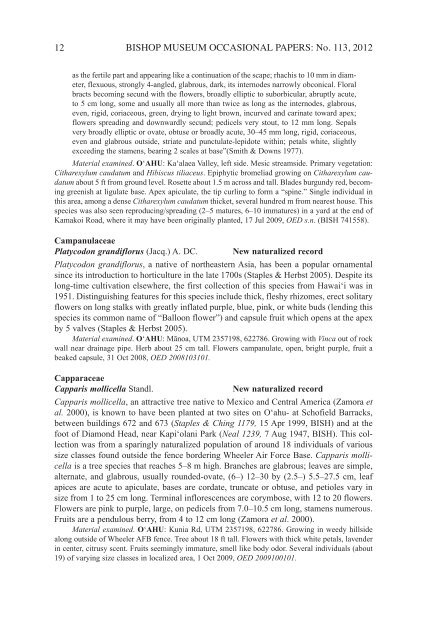OCCASIONAL PAPERS - Hawaii Biological Survey - Bishop Museum
OCCASIONAL PAPERS - Hawaii Biological Survey - Bishop Museum
OCCASIONAL PAPERS - Hawaii Biological Survey - Bishop Museum
Create successful ePaper yourself
Turn your PDF publications into a flip-book with our unique Google optimized e-Paper software.
12<br />
BISHOP MUSEUM <strong>OCCASIONAL</strong> <strong>PAPERS</strong>: No. 113, 2012<br />
as the fertile part and appearing like a continuation of the scape; rhachis to 10 mm in diameter,<br />
flexuous, strongly 4-angled, glabrous, dark, its internodes narrowly obconical. floral<br />
bracts becoming secund with the flowers, broadly elliptic to suborbicular, abruptly acute,<br />
to 5 cm long, some and usually all more than twice as long as the internodes, glabrous,<br />
even, rigid, coriaceous, green, drying to light brown, incurved and carinate toward apex;<br />
flowers spreading and downwardly secund; pedicels very stout, to 12 mm long. Sepals<br />
very broadly elliptic or ovate, obtuse or broadly acute, 30–45 mm long, rigid, coriaceous,<br />
even and glabrous outside, striate and punctulate-lepidote within; petals white, slightly<br />
exceeding the stamens, bearing 2 scales at base”(Smith & downs 1977).<br />
Material examined. O‘AHU: Ka‘alaea Valley, left side. Mesic streamside. Primary vegetation:<br />
Citharexylum caudatum and Hibiscus tiliaceus. Epiphytic bromeliad growing on Citharexylum caudatum<br />
about 5 ft from ground level. rosette about 1.5 m across and tall. Blades burgundy red, becoming<br />
greenish at ligulate base. apex apiculate, the tip curling to form a “spine.” Single individual in<br />
this area, among a dense Citharexylum caudatum thicket, several hundred m from nearest house. This<br />
species was also seen reproducing/spreading (2–5 matures, 6–10 immatures) in a yard at the end of<br />
Kamakoi road, where it may have been originally planted, 17 Jul 2009, OED s.n. (BISH 741558).<br />
Campanulaceae<br />
Platycodon grandiflorus (Jacq.) a. dc. New naturalized record<br />
Platycodon grandiflorus, a native of northeastern asia, has been a popular ornamental<br />
since its introduction to horticulture in the late 1700s (Staples & Herbst 2005). despite its<br />
long-time cultivation elsewhere, the first collection of this species from Hawai‘i was in<br />
1951. distinguishing features for this species include thick, fleshy rhizomes, erect solitary<br />
flowers on long stalks with greatly inflated purple, blue, pink, or white buds (lending this<br />
species its common name of “Balloon flower”) and capsule fruit which opens at the apex<br />
by 5 valves (Staples & Herbst 2005).<br />
Material examined. O‘AHU: Mānoa, UTM 2357198, 622786. Growing with Vinca out of rock<br />
wall near drainage pipe. Herb about 25 cm tall. flowers campanulate, open, bright purple, fruit a<br />
beaked capsule, 31 oct 2008, OED 2008103101.<br />
Capparaceae<br />
Capparis mollicella Standl. New naturalized record<br />
Capparis mollicella, an attractive tree native to Mexico and central america (Zamora et<br />
al. 2000), is known to have been planted at two sites on o‘ahu- at Schofield Barracks,<br />
between buildings 672 and 673 (Staples & Ching 1179, 15 apr 1999, BISH) and at the<br />
foot of diamond Head, near Kapi‘olani Park (Neal 1239, 7 aug 1947, BISH). This collection<br />
was from a sparingly naturalized population of around 18 individuals of various<br />
size classes found outside the fence bordering Wheeler air force Base. Capparis mollicella<br />
is a tree species that reaches 5–8 m high. Branches are glabrous; leaves are simple,<br />
alternate, and glabrous, usually rounded-ovate, (6–) 12–30 by (2.5–) 5.5–27.5 cm, leaf<br />
apices are acute to apiculate, bases are cordate, truncate or obtuse, and petioles vary in<br />
size from 1 to 25 cm long. Terminal inflorescences are corymbose, with 12 to 20 flowers.<br />
flowers are pink to purple, large, on pedicels from 7.0–10.5 cm long, stamens numerous.<br />
fruits are a pendulous berry, from 4 to 12 cm long (Zamora et al. 2000).<br />
Material examined. O‘AHU: Kunia rd, UTM 2357198, 622786. Growing in weedy hillside<br />
along outside of Wheeler afB fence. Tree about 18 ft tall. flowers with thick white petals, lavender<br />
in center, citrusy scent. fruits seemingly immature, smell like body odor. Several individuals (about<br />
19) of varying size classes in localized area, 1 oct 2009, OED 2009100101.

















